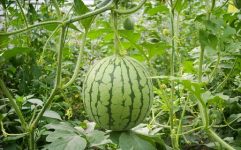
The Shanghai Academy of Agricultural Sciences wears an NFC tag for the watermelon, which can be recognized by a mobile phone
[ad_1]
“Authentic ‘8424’ is on the market.” “Nanhui 8424 arrives”…It’s time to eat melon again, and the fruit stalls on the streets and alleys in Shanghai quietly hang up the “golden signs” that appear every year. Many citizens were puzzled when choosing melons. Every family sold melons and boasted, who is the authentic “8424”? On the 2nd, the reporter saw in the experimental field of Zhuangxing of the Shanghai Academy of Agricultural Sciences that dozens of acres of melons are about to be listed here. Authentic “8424”, each has a smart “second-generation ID card”-a square NFC tag the size of a thumb, and a mobile phone “take a photo”. The birth certificate and growth file of each melon are vividly remembered. Real melon Fake melons can be seen at a glance.

“Generation ID card” has become the hardest hit by counterfeiting
From the table to the field, food safety must be “detailed from the beginning” if food safety is to be guaranteed throughout the process.
It is not uncommon for agricultural products to be issued an “identity card” before being sold on the market. From barcodes with a history of 42 years to QR codes for various applications, the “first generation ID card” is almost everywhere in the packaging of agricultural products, not only identifying brands, but also part-time to prevent counterfeiting. “The problem lies in the fact that the QR code is too easy to be copied, and the anti-counterfeiting capability of the’first-generation ID card’ is inherently poor.”
Dr. Wang Yunsheng from the Digital Agricultural Engineering and Technology Research Center of the Municipal Academy of Agricultural Sciences said that in fact, consumers scan the barcode or QR code and log on to the official website of the product to verify the identity. If they scan and log in again, they will no longer be able to pass the verification. This is because when the copied QR code was first logged in, it was recorded on the official website and included in the counterfeit “blacklist”, and it is difficult for consumers to be careful to “return the carbine”.
The first verification was successful because the QR code was copied and pasted on the counterfeit product, and the counterfeit product also had the same “ID card” as the genuine product. It cannot prevent copying, it is the biggest shortcoming of QR code or barcode, even if it is encrypted, it is useless. “At present, whether it is a barcode or a QR code, it is difficult to prevent counterfeiting.” Dr. Yunsheng Wang told reporters that since there are no technical barriers, the logos that were originally used to prevent counterfeiting have become “the hardest hit areas” for counterfeiting. Forged anti-counterfeiting marks have become an important part of the “counterfeit black industry chain”.
“Second Generation ID Card” Binding Growth File
There are no horizontal and vertical barcodes, and there are no popular QR codes. The Municipal Academy of Agricultural Sciences took the lead in issuing the “Second Generation ID Card” to the Shanghai-produced “8424” watermelon. It is just a small square green card with ” “Retroactive treasure”. This is an agricultural product “smart chip second-generation ID card” jointly developed by the Municipal Academy of Agricultural Sciences and Kunming Agricultural Products International Trade and Auction Center. “This kind of technology is not unfamiliar to Shanghai citizens. The anti-counterfeiting of Shanghai World Expo tickets is based on it.” Wang Yunsheng explained in detail. The data capacity is huge, and the Internet can be accessed in real time, which is difficult to copy.
“What’s more meaningful is that the data space of the smart’second-generation ID card’ is unlimited, and the huge data of the entire life cycle of crops can be read and written at any time. Consumers can use their mobile phones to use this as an entrance, scan anytime, anywhere, and then enter The growth database of this agricultural product.” Gu Xiaojun, deputy dean of the Municipal Academy of Agricultural Sciences, told reporters that in order to exchange the “second-generation ID card” for 8424 watermelons, the watermelon field in the Zhuangxing Comprehensive Experimental Station of the Academy of Agricultural Sciences has a copy of each watermelon. The “growth archive” of the whole life cycle. The file is refined to the location and shape of the planting plots, the basic situation of the base, the use of pesticides, the records of agricultural materials storage, which fertilizers have been used throughout the year, and what farmers do every day. In addition, after the use of pesticides, the impact on the ecology, the time and amount of harvesting, etc. are also included in the archives.
Starting from the end of May, the 8424 watermelons that are successively listed at the Zhuangxing Comprehensive Experimental Station of the Municipal Academy of Agricultural Sciences will carry the “second-generation ID card.” Information about a watermelon’s variety, place of production, planting mode, nutritional content, etc. Next, the watermelon “growth file” will be expanded, and all the agricultural products of Zhuangxing’s experimental field real estate will be included. When the grapes, rice and eggs are freshly marketed, the “second-generation ID cards” will also be renewed one after another.
Crops have growth files, agricultural products are sold with “second-generation ID cards,” and consumers have their mobile phones to “scan”. When the entire food safety becomes a “easy and checkable” closed loop, citizens are expected to “eat at ease.” “However, to be completely assured, NFC high-tech anti-counterfeiting needs to be continuously promoted, and it is best to trace it back to every tree, every flower, and every ear of rice. This is not only dependent on the further substantial reduction of chip costs, but also The crop’growth files’ are needed to cover all fields.” Gu Xiaojun said.
[ad_2]




